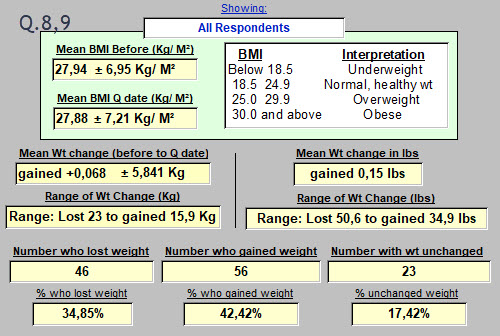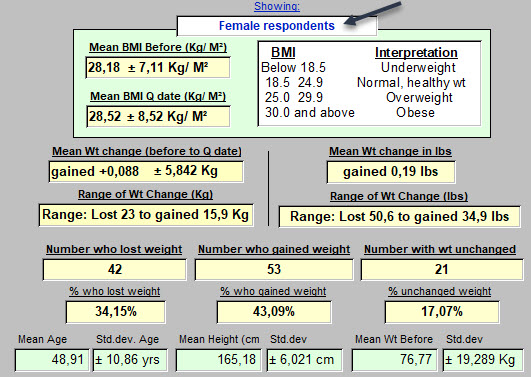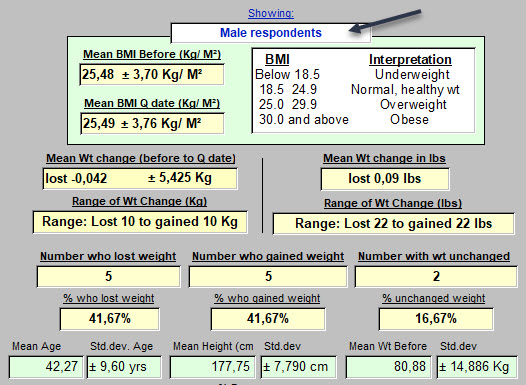Q.7, 8, 9 - Height, Weight before and on Q day
LTCOVID.com
Thanks for visiting!
To translate this page, select your
language from the dropdown menu below:
Respondents provided their Height, Weight Before becoming ill, and Weight on the day they answered the questionnaire.
These were used to calculate Body Mass Index and compare with Standards for the respondents country.
Q.7 - Height
Mean height and weight for the sample of 132 were as follows:
The following height and weight standard values were applied:
For this sample, below are the differences from these standards: they are taller and larger than average.
Q.8, 9 - Weight and Body Mass Index (BMI) BEFORE becoming ill, and on the day of questionnare response.
Values obtained are compared with standards from the country of residence.
- Before becoming ill, these respondents taken as a group (n = 132) were overweight.
- BMI was 27.4 Kg/ M² before becoming ill
- Expressed as an average, on the day of response, this sample was still in the overweight category.
- On average, a weight gain of 0.07Kg or 0.2lbs took place from the weight before to the weight on the questionnaire response date.
- This mean weight gain had a significant standard deviation of 5.8Kg. This represents a range from losing 23 Kg to gaining 15.9Kg.
- 46 (35%) lost weight. The majority, 56 (42.4%) gained weight, and 23 (17.4%) reported a weight that had not changed.
----------
In this presentation of results for the complete sample, distinctions and comparisons of subgroups are usually not made. This will be done subsequently.
But because these values and their standards are very influenced by gender, some further categorization here seems indicated:
Values for females (n = 123)
Values for males, with associated data. (n = 12)
Since age by gender is presented, are these different?
F: 48.91±10.86 yrs n = 123
M: 42.27±9.60 yrs. n = 12
By Student's two-tailed t-test for unpaired data, t=2.0402, df = 133, S.E. of diff. = 3.255, p = 0.0433.
The mean of Female age minus Male age equals 6.6400
95% confidence interval of this difference: From 0.2026 to 13.0774 years different.
So our elected sample size permits distinguishing a significant difference between female respondents (who are older) and male respondents, for these subgroups presenting with "long-term" COVID-19.
Further observations:
- Body size information (Height, Weight both Before illness and on response day) was complete for 125 respondents.
- 40 had a normal weight before illness began and maintained a normal weight
- 10 were not overweight but became so during this illness
- 4 were not obese but became so
- 36 (28.8%) were obese before this illness began. (Of all adults in the UK, 28.7% were obese - Health Survey 2017). Figures for 2020 UK Find 29% of females are obese, and 26% of males.
- 35 female respondents were obese (BMI>30Kg/ M²) before illness began.
- 1 of 12 male respondents was obese (BMI>30 Kg/ M²) before illness.
- 5 respondents were Class III obese (BMI >40 Kg/M²) and remained so
- 3 were underweight before becoming ill
- 46 lost weight during the illness
- 54 gained weight during the illness
- 9 were obese before the illness but lost weight to pass to the overweight category of BMI.
IMPRESSIONS:
- This sample was slightly taller than average and on average larger than the standard reference. Suggesting that they represent a larger target or surface for potential viral transmission seems a bit far-fetched but cannot be excluded.
- Levels of obesity were not different than those found in the population from where the majority of respondents were drawn.
- Weight loss, weight gain, and an unchanged weight are all in evidence in these respondents presenting with "long-term" COVID-19. And yet, the majority have gained varying amounts of weight.
- Several reports have studied effects of the SARS-CoV-2 virus on the adipocyte. Here is one. They suggest that changes in the adipocyte favor weight gain for several reasons. These include :
-
-
- an increase in inflammation with specific cells (macrophages, our 'vacuum-cleaner' cells for example are one good choice) causing ...
- a reduction in leptin in fat cells
- leading to increased fat accumulation in those cells
- a reduction in breakdown of these fats for energy use
- a reduction in lipid oxidation (burning fat) and fatty acid synthesis (which would use the fat to make other things like cellular memebranes for example)
- more uptake of glucose by fat cells, leading to an energy surplus
- more adipocyte proliferation and differentiation (more fat cells) than before
- normal weight gain usually involves filling cells that are already present with more fat. But not making new fat cells.
- but now, more fat cells are being made, just waiting to fill up with: fat.
-
Possible links of BMI to delay in diagnosis, duration of illness and other variables will be presented subsequently.
A final somewhat simplistic but essentail comment: Those with a larger body size, have larger energy demands to keep that body going. What happens when these become depleted?
A post-final simplistic thought: Our stereotypic thoughts about overweight and obesity may blind us to important relevant findings in the setting of "long-term" COVID-19 illness. One well-known problem, confirmed by this questionnaire, is that of Sortness of Breath (SOB). This is accompanied most often by diminished levels of oxygen in blood (hypoxemia- and at a cellular level (tissue hypoxia). Those who are obese, but can and do still move around, are quickly challenged in terms of oxygen delivery. Ask a Class II obese person to walk up and down two flights of stairs, then measure spO2. So on a daily basis, the obese are in training for functioning in hypoxic states. Just like a mountain climber, and perhaps even more than a marathon runner. The answers to other questions here, may find a relation to this topic. The key symptom is fatigue. The obese person at the end of the two flights up and down, looks fatigued.
Q.10 - Questionnaire response date >>>>>
A découvrir aussi
- Q. 15 - Additional (non-allopathic) therapies
- Q. 17 - Medications are taken based on which sources of information?
- Q. 20 - Date diagnosed with the COVID-19 illness






